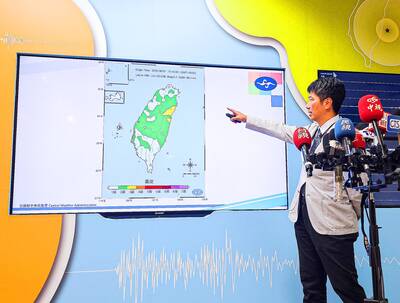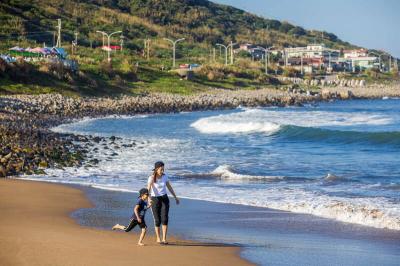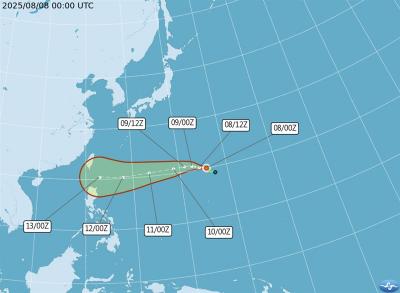Stem cells found in umbilical cord blood are useful not only for transplants, but also for drug-testing by the pharmaceutical industry, according to research presented yesterday in Taipei.
“Over 130 million children are born each year, making umbilical cord blood the largest stem cell source available on the planet,” said Colin McGuckin, a professor at the Centre for Regenerative Medicine at Newcastle University in England.
McGuckin’s findings were presented yesterday at the 2008 Taiwan International Somatic Stem Cell Symposium, attended by about 200 doctors and experts from Taiwan, the US and the UK.
“There are 85 diseases which are treatable with cord blood ... and over 10,000 people have already been successfully treated with cord blood,” he said.
McGuckin listed several advantages of cord blood over other sources of stem cells, including that collecting cord blood is non-invasive and ethically acceptable to almost every religion.
His research found that defined neural, hepatic, epithelial and pancreatic tissues could be produced from cord blood.
Stem cells derived from cord blood not only have potential for tissue-engineering for transplants, but also for differentiating human cord blood cells into liver cells, he said. This could be useful to the pharmaceutical industry, he said.
“Umbilical cord blood can be of use ... for the development of defined tissues for making drugs and for toxicity testing, which is increasingly important for the creation of humanized drugs,” McGuckin said.
“A majority of normal drugs are tested first on animals ... but animal cells are not exactly like human cells,” McGuckin said.
He recalled the TeGenero disaster of 2006, when clinical trials of the drug TGN1412 resulted in near-fatal side effects on its test subjects.
Similar cases can be averted in the future with the development of liver cells that have been produced from human cord blood stem cells, McGuckin said.
McGuckin also called for establishing public cord blood banks worldwide, because “if no cord blood gets stored, then no one gets treated,” he said.

Aftershocks from a magnitude 6.2 earthquake that struck off Yilan County at 3:45pm yesterday could reach a magnitude of 5 to 5.5, the Central Weather Administration (CWA) said. Seismological Center technical officer Chiu Chun-ta (邱俊達) told a news conference that the epicenter of the temblor was more than 100km from Taiwan. Although predicted to measure between magnitude 5 and 5.5, the aftershocks would reach an intensity of 1 on Taiwan’s 7-tier scale, which gauges the actual effect of an earthquake, he said. The earthquake lasted longer in Taipei because the city is in a basin, he said. The quake’s epicenter was about 128.9km east-southeast

GENSLER SURVEY: ‘Economic infrastructure is not enough. A city needs to inspire pride, offer moments of joy and foster a sense of belonging,’ the company said Taipei was named the city with the “highest staying power” in the world by US-based design and architecture firm Gensler. The Taiwanese capital earned the top spot among 65 cities across six continents with 64 percent of Taipei respondents in a survey of 33,000 people saying they wanted to stay in the city. Rounding out the top five were Vietnam’s Ho Chi Minh City (61 percent), Singapore (59 percent), Sydney (58 percent) and Berlin (51 percent). Sixth to 10th place went to Monterrey, Mexico; Munich, Germany; Sao Paulo, Brazil; Vancouver; and Seoul. Cities in the US were ranked separately, with Minneapolis first at

The New Taipei City Government today warned about the often-overlooked dangers of playing in water, and recommended safe swimming destinations to cool off from the summer heat. The following locations in the city as safe and fun for those looking to enjoy the water: Chienshuiwan (淺水灣), Baishawan (白沙灣), Jhongjiao Bay (中角灣), Fulong Beach Resort (福隆海水浴場) and Sansia District’s (三峽) Dabao River (大豹溪), New Taipei City Tourism and Travel Department Director-General Yang Tsung-min (楊宗珉) said. Outdoor bodies of water have variables outside of human control, such as changing currents, differing elevations and environmental hazards, all of which can lead to accidents, Yang said. Sudden

Tropical Storm Podul has formed over waters north-northeast of Guam and is expected to approach the seas southeast of Taiwan next week, the Central Weather Administration (CWA) said today. The 11th Pacific storm of the year developed at 2am over waters about 2,660km east of Oluanpi (歐鑾鼻), Pingtung County — Taiwan's southernmost tip. It is projected to move westward and could have its most significant impact on Taiwan on Wednesday and Thursday next week, the CWA said. The agency did not rule out the possibility of issuing a sea warning at that time. According to the CWA's latest update, Podul is drifting west-northwest